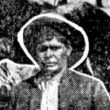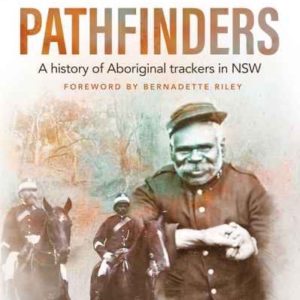Loading map...

This article is reproduced with the kind permission of the team at Koori History. See the original article written by John T. Patten at https://koorihistory.com/tracker-patten/
John James Patten, known as Jack Patten, was born in the Snowy Mountains of Victoria at Corryong in 1874. He was the eldest son of John Patten, a man for whom there is little record, and his partner Maggie Simms, a Koori woman for whom local oral tradition suggests an origin within the Tumut district.
At the age of four, Jack and his three siblings were orphaned when their mother was found lying lifeless in a field on the outskirts of Corryong. Placed in the care of James Wheeler, a local settler with family ties to the local Koori community, Jack and his three siblings: Bella Lee, Minnie Lee and the infant Jacob Patten were soon thereafter placed in the custody of the Victorian Board for the Protection of Aborigines (BPA) and sent to Coranderrk Aboriginal Station, near Healesville.
At Coranderrk Jack and his siblings were cared for by the community at the station, with baby Jacob being adopted by Henry and Maggie Nelson, whilst Jack attended the station school, showing flair as a scholar and showing early signs of the attention to detail which would serve him well later in life.
In 1882 the Patten brothers education as trackers began following the marriage of their eldest sister Bella Lee to the tracker Thomas Spider, a Cooktown, Queensland native who had been brought to Victoria as part of a detachment of police trackers, engaged with the specific aim of capturing the fugitive Ned Kelly and his gang of outlaws.
Their time at Coranderrk station was harrowing experience for the small family. The period saw Jack suffering from typhoid in 1883, the death of the youngest sister Minnie in the same year, followed by the death of both Bella Spider and her two year old daughter Catherine Spider in 1885. A year later Tracker Spider had also died, leaving only the two Patten brothers behind.
Following the death of his brother in-law and mentor Thomas Spider, Jack requested to be released from Coranderrk, hoping to follow his brother Jacob, who had moved with his adoptive parents to Framlingham Aboriginal Station, near Warrnambool, however Jack’s request was denied.
By 1888 Jack was 13 years old and subject to the “Half-Caste Act” which meant that no Aboriginal person of that age or beyond, with any measure of non-Indigenous ancestry could remain on any of the Government funded or controlled mission stations, unless their labour was required. The order resulting in the expulsion of Jack along with two other boys was signed by Alfred Deakin.
Throughout the 1890’s Jack travelled extensively, building a reputation as he participated in athletic carnivals and football matches throughout Victoria and the Riverina of New South Wales, often in the company of his friend Chris “Pompey” Austin. During his travels Jack formed a relationship with Louisa Ross at Framlingham., with whom Jack had two sons.
Following efforts by the Woodford police to have “half-caste” men removed from camping on the agricultural reserve near Framlingham station, Jack relocated to Cummeragunja Aboriginal Station on the Murray River, seemingly unaware that his former partner Lena Austin was pregnant and had also been subject to victimisation by the Woodford police and the BPA. Lena gave birth to Jack’s daughter Maria Johanna Austin in 1901.
In 1902 Jack Patten’s efforts on the football field led him to return to Cummeragunja, where he would meet Christina Middleton, the youngest daughter of George Middleton, a Dhulinyagen, Yorta Yorta man who owned a farm adjacent to Cummeragunja. Jack and Christina soon began to build a large family with their first child Theresa Patten born two months after their marriage in June 1902.
By 1907 the Patten family had relocated to Tumbarumba where Jack’s brother, going by his adoptive name of Jacob Nelson was stationed as the local tracker, in the company of his wife Sarah Nelson (nee McRae).
Following a racially motivated altercation between Jacob Nelson and Constable Shields in December 1907, Tracker Nelson was relieved of his position and sentenced to one month prison at Albury. Jacob’s role was then filled by his brother, Jack, with this being the beginning of a long career in the service of the law.
In 1911 Tracker Patten and his family relocated to Wagga Wagga in relief of the Tracker Whyman McLean, another former resident of Cummeragunja station. Tracker Patten would be based at Wagga Wagga for two years, participating in a number of cases, including the successful capture of an escaped prisoner after a long bicycle based pursuit through North Wagga Wagga.[ref]1911 ‘ATTEMPT TO ESCAPE FROM CUSTODY.’, The Border Morning Mail and Riverina Times (Albury, NSW : 1903 – 1920), 24 May, p. 2. http://nla.gov.au/nla.news-article108942069[/ref].
Beginning in 1913, Tracker Patten and his family were stationed in West Wyalong, serving with the Ungarie and Wyalong Police department. There they became an appreciated fixture among the community, providing the Patten children an opportunity to attend the local high school, which at the time was a rare option for Koori children in New South Wales.
In her autobiography, “If Everyone Cared”, Tracker Patten’s niece Margaret Tucker related some stories of her Uncle:
“Tales of his findings were never-ending. He always went with the police on sheep and cattle stealing cases, and often on cases of murder. Jack Patten did not talk about himself, but his white and dark friends loved telling stories of his powers of observation.
On one occasion Jack went with the police to investigate the murder of a white woman and her son in a bush hut. Her other son told the police he had gone home and found them murdered. Jack found a blood-stained axe cunningly hidden in the bush. He went to a gum tree where he noticed recent axe marks. The jagged edge of the axe he’d found matched up with the marks in the tree and on wood left on the wood heap, which lead him to believe that the brother himself was the murderer. Further clever sleuthing proved this to be the case.
On another occasion the police were called out to deal with cattle stealing. As usual they took Jack. They found nothing, but persevered and went out again several times. One night they went to an outback cottage. While the police were snooping around outside, Jack went inside where he found a game of cards in progress on a long kitchen table. He sat down on the wooden bench families used in those days. Jack noticed that the men were trying not to be fidgety and as he watched his hands were feeling around underneath the table. He discovered there was a furry substance nailed underneath. Later the men were charged with the stealing of the cattle and selling their skins to a gang of crooks.”[ref]1975 ‘If Everyone Cared’, Grosvenor Books (London, ENG)[/ref].
During another of Tracker Patten’s documented cases he was able to determine the location of a missing man’s body, having revisited a previously dismissed mineshaft, locating finger marks within the shaft, indicating the efforts of the man as he was falling to his death.[ref]1917 ‘Sad Occurrence.’, The Wyalong Advocate and Mining, Agricultural and Pastoral Gazette (NSW : 1900 – 1928), 7 March, p. 2. http://nla.gov.au/nla.news-article108600721[/ref]
Jack Patten’s ability as a tracker was remarked upon greatly and is exemplified by his ability to follow tracks in difficult situations per the following quote, highlighting his location of a missing eight year old girl, having found her after following her tracks at night:
“Tracker Patten got to work. Picking up the track, he displayed remarkable skill in following the tracks in the moonlight right along the route she had taken almost to West Wyalong when it was reported that she had turned up at Cullen’s Metropolitan Hotel.” [ref]1922 ‘PERSONAL’, The Wyalong Advocate and Mining, Agricultural and Pastoral Gazette (NSW : 1900 – 1928), 14 March, p. 5. http://nla.gov.au/nla.news-article116186643[/ref]
Tracker Patten retired from active duty in 1928, relocating with his family to Salt Pan Creek and then Dee Why and La Perouse in Sydney. There he became involved in Aboriginal politics, in support of Fred Maynard’s Australian Aborigines Progressive Association, the forerunner to the organisation that his son, Jack Patten Jnr would later co-found in 1937.
Tracker Jack Patten Snr eventually settled at Mooroopna back on Yorta Yorta country, dying there in 1942. He is buried at Cummeragunja Aboriginal Cemetery and was survived by sons Peter Ross, William Ross, Jack Patten Jnr, George Patten, Osley Patten and daughter’s Ethel Rudd, Minnie Dudman, Bella Onus and Maria Austin.
Epilogue: Tracker Jacob Nelson’s career began whilst he was living at Warangesda Mission Station near Hay in the New South Wales Riverina where he married Sarah McRae in 1905. His career came to abrupt end in 1907 and he spent the rest of his remaining years as a boundary rider and labourer. Jacob Nelson died in 1923 at the age of 45 and is buried in the grounds of Sunbury asylum. His wife Sarah McRae later remarried to William Cooper.

 This website explores the history of Aboriginal trackers in NSW from 1862 when the current NSW Police Force was established through to 1973 when the last tracker, Norman Walford, retired. You can read about the lives of individual trackers and some of the incredible tracking feats they...
This website explores the history of Aboriginal trackers in NSW from 1862 when the current NSW Police Force was established through to 1973 when the last tracker, Norman Walford, retired. You can read about the lives of individual trackers and some of the incredible tracking feats they...

There were over 200 NSW police stations that employed Aboriginal trackers between 1862 and 1973. Many were concentrated in the central-west and north-west of the state, the agricultural and pastoral heartland of NSW. This is because one of the main jobs of trackers was to pursue sheep, cattle and horse thieves. Trackers sometimes lived in small huts out the back...
Learn More ►
Pathfinders book Pathfinders, A history of Aboriginal trackers in NSW, written by Dr Michael Bennett and published by NewSouth, is now available from all good bookstores. Click on the link below to order your copy. https://www.abbeys.com.au/book/pathfinders-a-history-of-aboriginal-trackers-in-nsw.do Early History Since the beginning of the colony, government agencies, explorers, surveyors and members of the general public called upon the tracking...
Learn More ►